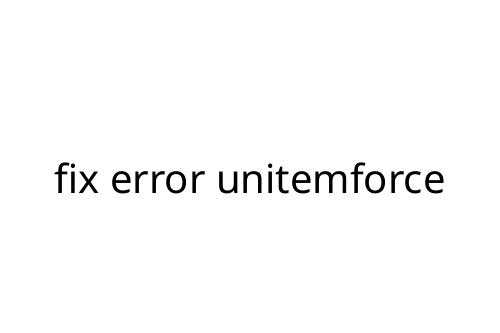fix error unitemforce
Encountering the “unitemforce” error can disrupt workflows and cause confusion, especially if you’re in the middle of a task. Whether you see it during a software setup, coding session, or while dealing with system configurations, addressing this error quickly is essential. Here’s what you should know about the “fix error unitemforce” issue, including possible causes, troubleshooting steps, and practical advice.
What is the “unitemforce” error?
The term “unitemforce” doesn’t point to a widely known software or standardized error, but it appears in several support threads and help forums. Typically, the error shows up in scenarios involving program execution, module imports, or command-line tools. Some users see it while scripting or deploying automation tasks; others encounter it in software build environments.
The root cause often ties to typos, outdated dependencies, missing components, or registry issues. Sometimes it’s related to environments (like Python, Node.js, or other scripting platforms) where a package or resource can’t be found or executed correctly.
Common causes
- Typographical errors: A misspelled command or package name (e.g., “unitemforce” instead of an expected command).
- Dependency issues: Modules or packages that are missing or corrupted.
- Environment path problems: Incorrect system or environment variables can cause this error.
- Version conflicts: Outdated software or incompatible component versions.
Knowing where and when fix error unitemforce appears helps narrow down the best solution.
How to fix error unitemforce: Step-by-step
1. Double-check command spelling and syntax
One of the quickest things to confirm. Make sure you haven’t made a typo in your command or script. Even a small misspelling can trigger the error.
2. Verify dependencies and installations
Check that all required packages, modules, or libraries are properly installed. If using a tool like pip, npm, or apt, run their respective commands to see if “unitemforce” is recognized or to list installed packages.
3. Review environment variables
Sometimes, the problem relates to how your system’s PATH or other variables are set. Make sure any scripts or executables involved in the task are included in the environment variables.
4. Look for version conflicts
If you’re updating or redeploying software regularly, incompatible versions may cause errors. Compare the version requirements in your configuration files with what’s installed.
5. Search for specific documentation
Since “unitemforce” is an unusual term, look for case-sensitive variations or related keywords in your platform’s documentation or forums. There’s a chance the error relates to a misnamed command or rare package.
Pros and cons of quick fixes
Pros:
- Rapid troubleshooting reduces downtime
- Encourages double-checking system details
- Often resolves the issue without major changes
Cons:
- Temporary fixes may hide underlying issues
- Mistyping can be easy to overlook
- Some causes may require deeper technical adjustment
Final thoughts
The fix error unitemforce situation often comes down to details: spelling, compatibility, or missing components. Approach the error methodically, check each of the areas above, and don’t hesitate to consult online communities if you’re stuck. Taking it step by step keeps you moving forward, minimizes disruptions, and builds confidence in troubleshooting similar issues.


 _____
Marshane Jacobsin – Digital Tools Developer
Marshane Jacobsin is the tech innovator on the team. She designs and develops intuitive tools that empower gamblers, from calculators to betting trackers. Marshane's expertise ensures that users have access to cutting-edge resources that enhance their gambling strategies while promoting responsible play.
_____
Marshane Jacobsin – Digital Tools Developer
Marshane Jacobsin is the tech innovator on the team. She designs and develops intuitive tools that empower gamblers, from calculators to betting trackers. Marshane's expertise ensures that users have access to cutting-edge resources that enhance their gambling strategies while promoting responsible play.